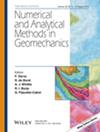含间隙流体的颗粒流动数值模型
IF 3.6
2区 工程技术
Q2 ENGINEERING, GEOLOGICAL
International Journal for Numerical and Analytical Methods in Geomechanics
Pub Date : 2025-04-22
DOI:10.1002/nag.3990
引用次数: 0
摘要
我们提出了一种针对类固态和类流态的颗粒流动力学行为的构成模型。应力速率张量被分解为与速率无关的部分和与速率有关的部分。与速率无关的部分采用低塑性模型,与速率有关的部分采用-型流变模型。在与速率相关的模型部分,引入了斯托克斯数来捕捉间隙流体粘度的影响。通过对颗粒材料和颗粒-流体混合物的元素试验进行数值模拟,证明了模型的性能。本文章由计算机程序翻译,如有差异,请以英文原文为准。
Numerical Model for Granular Flow With Interstitial Fluid
We present a constitutive model for the mechanical behavior of granular flow for both solid-like and fluid-like regimes. The stress rate tensor is decomposed into rate-independent and rate-dependent parts. The hypoplastic model is used for the rate-independent part, while the -type rheological model is employed for the rate-dependent part. The Stokes number is introduced to capture the influence of interstitial fluid viscosity within the rate-dependent part of the model. The model performance is demonstrated through numerical simulations of element tests, encompassing both granular materials and granular-fluid mixtures.
求助全文
通过发布文献求助,成功后即可免费获取论文全文。
去求助
来源期刊
CiteScore
6.40
自引率
12.50%
发文量
160
审稿时长
9 months
期刊介绍:
The journal welcomes manuscripts that substantially contribute to the understanding of the complex mechanical behaviour of geomaterials (soils, rocks, concrete, ice, snow, and powders), through innovative experimental techniques, and/or through the development of novel numerical or hybrid experimental/numerical modelling concepts in geomechanics. Topics of interest include instabilities and localization, interface and surface phenomena, fracture and failure, multi-physics and other time-dependent phenomena, micromechanics and multi-scale methods, and inverse analysis and stochastic methods. Papers related to energy and environmental issues are particularly welcome. The illustration of the proposed methods and techniques to engineering problems is encouraged. However, manuscripts dealing with applications of existing methods, or proposing incremental improvements to existing methods – in particular marginal extensions of existing analytical solutions or numerical methods – will not be considered for review.

 求助内容:
求助内容: 应助结果提醒方式:
应助结果提醒方式:


